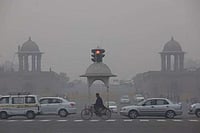Vintage Charm
A comfortable train journey of seven hours from Howrah station to Ranchi is how our trip to Jharkhand begins one spring morning. A pleasant journey by road takes us from Ranchi to McCluskieganj. A small blue sign and a few hostels later, we see the red-brick railway station of McCluskiesganj. Checking into our guest house, we decide to walk around a bit, right up to the station. The train from Gomoh has left just a while ago and people are climbing the over bridge and moving out. There is a distinct chill as it darkens, a contrast to the bright sunny day.
In the 1930s, Ernest Timothy McCluskie, a property dealer based in Calcutta, had leased out some land from the Maharaja of Ratu to set up an Anglo-Indian colony here. The place—McCluskieganj— was named after him. Anglo-Indian families were invited to buy plots and settle down here. Many of the bungalows are now in a state of neglect, with foliage all around. Most of them were sold by the Anglo-Indian families who had owned them when they moved abroad.
Beauty Among Ruins
A few of the bungalows, such as Bakshi Bungalow, are well-maintained. This is where the film Death in the Gunj, directed by Konkona Sen Sharma, was shot. A caretaker and his family having their meal in the outhouse of the Bakshi Bungalow are oblivious to us; clearly they are used to tourists visiting. The compound has several mango trees laden with flowers and many other flowering plants all around. A second gate is open on the other side from which the railway line could be seen. Prasad Bungalow is in a much better state as is another one close to it, in green and red. It used to belong to actress and director Aparna Sen. In several of the compounds, we find palash trees (dhak/Butea monosperma/Flame of the Forest) and mango trees and fields where arhar (pigeon pea lentils) are being cultivated, the green pods ripe and ready for harvesting. The bungalow that belonged to the Bengali novelist Buddhadeb Guha is in a sorry state. A lone caretaker sits down and complains to us about its maintenance. On both sides of the path that leads to the bungalow are more green fields.
A Feast for the Senses
We drive a little way crossing an old church—St John’s—that seems to have had a fresh coat of yellow paint. Built in 1940, the church is now under lock and key. Umesh, our driver, asks us if we would like to see ‘Sarva Dharma Sthal’ in the village of Dhuli not very far away, an area that has a temple, a mosque and a crucifix all in one place. What draws our attention is a signboard nearby that announces ‘Sita Kund’, kund meaning reservoir or tank. All around it are palash trees, bright and radiant, a dreamscape in orange. Our next stop is the cemetery. The gate to the cemetery is no longer functional, its pillars weighed down and many of the old graves are in a poor state with their marble headstones removed. Some of the epitaphs and names are illegible. Here too are the palash are in full bloom—life and death completely intertwined.
As we travel along the well-maintained roads, we also see sal and mahua trees all over the place, on both sides of the roads. The fallen leaves create a brown carpet on the earth and the contrast of the green and the brown with the orange patches of the palash thrown in makes our Holi special and colourful. The Chatti river that is reached via a picturesque drive is a fascinating spectacle as years of erosion have endowed the place with an almost canyon-like look. A little further down is the Dega-degi river that was just a small trickle. We travel a little further to the Damador river that marks the boundary of the Latehar district in which McCluskieganj is located but the river is completely dry.
Frozen in Time
Known as ‘Mini England’ and ‘Mini London’, McCluskieganj has a wonderful charm to it, one that lingers. The old bungalows that speak of times past, the charming walks through the sal and mahua trees with the sun streaming in, the scintillating play of light and shadow and the exquisite rock formations that the Chatti river has created make McCluskiesganj a delectable slice of India that needs to be explored. Spring endows the place with more colours, with the vivid colours of the palash flowers captivating the senses.
(This appeared in the print edition as "Gunj Diary")
Nishi Pulugurtha is Associate Professor, Department of English, Brahmananda Keshab Chandra College, Kolkata






















.png?w=200&auto=format%2Ccompress&fit=max)



